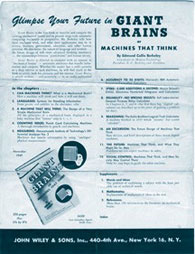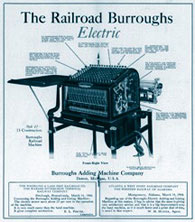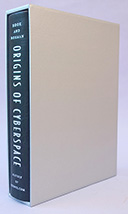Publications History of Computing (also found under Bibliography and Science and Technology)


Origins of Cyberspace: A Library on the History of Computing, Networking and Telecommunications
Diana H. Hook and
Jeremy M. Norman
With contributions by Michael R. Williams
$500.00
81/2 x 11 inches. x, 670pp. mostly printed in two columns.
284 illustrations. Printed in two colors throughout on Fortune Matte 80 pound acid-free paper. Bound in heavy cloth with silver stamping. ISBN 0-930405-85-4. Edition limited to 500 copies. Novato, 2002. 38301.
» Skip to: Reviews
Origins of Cyberspace describes the Jeremy Norman library of technical reports, books, pamphlets, blueprints, typescripts, manuscripts, photographs, and ephemera on the history of computing and computer-related aspects of telecommunications, from the early seventeenth century to about 1969 and includes 1411 annotated entries.
- Download the prospectus.
- Download the entire author and subject index for a detailed view of the people and topics covered in the book.

Limited Edition — Origins of Cyberspace: A Library on the History of Computing, Networking and Telecommunications $2000.00
Besides the regular limited edition, fifteen copies, numbered from 1-15 in binary, signed by the coauthors, the designer, and the binder, have been bound in full leather, all edges gilt, in a cloth slipcase. The first nine of these included an original vintage print of the ENIAC duplicated in the Pres Eckert papers; these are now out of print. Copies 10 through 15 do not include the vintage photograph.
 Pres Eckert (center left) and John Mauchly (center right) working with the ENIAC, the first large-scale general-purpose electronic digital computer, from which all later electronic digital computers descend. Also visible in the photograph (left to right) are Pfc. Homer Spence, Elizabeth Jennings, Herman H. Goldstine and Ruth Lichterman. First operational in May 1945, the ENIAC was announced to the public in February 1946. From 1945 to 1948 it was the only operating electronic digital computer in the world. It weighed 30 tons, contained 18,000 vacuum tubes, 70,000 resistors, 10,000 capacitors, 6000 switches, and 1500 relays, and required 174 kilowatts to run. (Photograph used by permission of the University of Pennsylvania’s School of Engineering and Applied Science.)
Pres Eckert (center left) and John Mauchly (center right) working with the ENIAC, the first large-scale general-purpose electronic digital computer, from which all later electronic digital computers descend. Also visible in the photograph (left to right) are Pfc. Homer Spence, Elizabeth Jennings, Herman H. Goldstine and Ruth Lichterman. First operational in May 1945, the ENIAC was announced to the public in February 1946. From 1945 to 1948 it was the only operating electronic digital computer in the world. It weighed 30 tons, contained 18,000 vacuum tubes, 70,000 resistors, 10,000 capacitors, 6000 switches, and 1500 relays, and required 174 kilowatts to run. (Photograph used by permission of the University of Pennsylvania’s School of Engineering and Applied Science.)
Reviews
“Chronicling the history of computing, 1613-1970, this beautiful reference book is wonderfully illustrated by copies of pamphlets, letters, blueprints, and many other useful images. It presents a more serious and thorough treatment than the subject has received in other recent books. Especially useful is the far-reaching history, often ignored, of contributions that led to advances in computing.… The authors’ backgrounds in rare books show in the collection of documents, entries, and images, which are unusual and include important details. One example is a reproduction of an advertisement with one of the earliest uses of the word ’computer.’ An excellent and refreshing book for large public and middle to large academic libraries.”
—M. S. Brown-De Sica, in Choice: Current Reviews for Academic Libraries (October 2002).
“I’m not sure whether it is brave or rash to publish a bibliography on the history of computing, but in my view the medal for bravery should be awarded to Hook and Norman for this first large-scale attempt at defining the important and most influential works on the history and development of computing by mechanical or electronic means. The rash aspect is that they must be hopeful of not having left out something that will later be seen as fundamentally important. With that in mind, a cut-off date of the early 1970s (the time when the floppy disc was introduced) seems a wise move.
“The bulk of the volume is a catalogue of a collection, “a library of technical reports, books, pamphlets, ephemera, letters, typescripts, manuscripts, prints, photographs, blueprints and medals on the history of computing, networking and related aspects of telecommunications.” Those familiar with Hook and Norman’s past joint publication The Haskell F. Norman Library of Science and Medicine, 1991, (now dispersed) will know what to expect in terms of format.
“However, the task facing the authors is somehow different from science and medicine for in these subjects both are well-documented and researched. The history of computing is in comparison an infant-collecting theme comparatively unexplored. Thankfully, we are given a 60-page introduction which forms a key to this work, encompassing a history of computing as it relates to this amassing of the collection. Jeremy Norman modestly consigns to a footnote his exertions and frustrations over the “umpteenth” draft before he would let this introductory essay go to press. Written, as he admits, as much for himself as for the reader, he tries to make sense and order of what is and has been important or significant, and what more daringly could be left out. As a further support to the catalogue, the authors have constructed an indispensable timeline running from 1599 to 1990, pinpointing all the key inventions, publications and events which, in turn, is cross-referenced to the item numbers in the collection.
“If this all sounds a bit too technical, you would be wrong. With an item count of 1,411, the catalogue has managed to bring in every conceivable artefact procurable, and I do mean artefact, so that it can be read as lucidly as possible by the non-computer literate. Also, the catalogue is not restricted to the collection alone but includes additional works recognised for their importance. The first item listed in the timeline is Galileo’s Le operazioni del compasso geometrico et militare, published at Padua in 1606. The most recent copy to come to auction was in 1988 when it reached a hammer price of £26,000. Rarer still is Pascal’s pamphlet of 1645: Lettre dedicatoire a monseigneur le Chancelier sur le sujet de la machine nouvellement… describing his adding machine, the Pascaline. This item has probably not been seen for sale by any living collector or bookseller, so it is hardly a surprise that this too is not part of the collection.
“What also becomes very apparent is that there is pretty well no linear structure to computer history. Indeed, from the late 1930s, competing computer design and languages have been developed, dropped and reused at an alarming rate. Computer technology seems to be of such ephemeral existence that the bulk of the 20th century publications appear to be the rarest part of the collection.
“So here we have a bibliography, that will, I predict, become the standard reference work with the statement “Not in Cyberspace” becoming the abbreviation for future online catalogue readers and collectors to decipher. A future hope is that when the post-1970s computing literature comes collected and codified in future collections and bibliographies, my Window’s 3.1 User Guide will justify an inclusion.“
—Jolyon Hudson, in Antiquarian Book Review (Dec/Jan 2002).
« back to all History of Computing Publications
back to top
